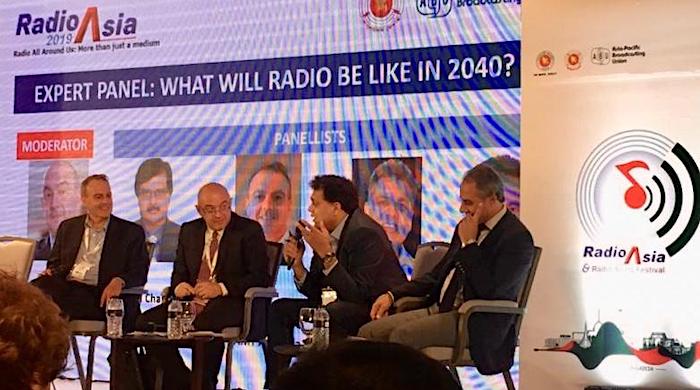In a plenary session on the future of radio at the Radio Asia conference in Bangladesh this week, Steve Ahern took a glimpse forward 20 years in a live audio simulation of the changes ahead.
Putting on a pair of wearable earbuds, a thin strip of plastic that attached to the ear lobe, Ahern explained that the vibrations from the wearables work like headphones, expect that they stimulate the ear canal to put sound directly into his head, and use skull cavity resonance to generate the bass sounds.
Once he bluetoothed the sound to the PA system, delegates could also hear the audio.
Tapping his earlobe to activate the system, then using voice commands, he first asked the interactive audio interface to scan for local radio stations, finally settling on Bangla music from the national broadcaster Bangladesh Betar.
After enjoying the local stations, he asked his wearable audio interface to play music from his Spotify account. After a short time, it was interrupted by an incoming voicemail from his wife and later another interruption reminded him to pick up dog food on his way home.
Since it was dinner time in Australia, the interface suggested some recipes. After settling on a recipe for Spaghetti, the interface played his favourite Dublin radio station from a live stream as background, while setting a reminder for the 15 minutes it would take to boil the water.
“Of course this is a simulation, these are really just bandaids,” he revealed after it was over. “But all of this is real, most of it can be done today with voice control, artificial intelligence, connected streams and integration of audio sources and routines. Audio wearables are also a real thing, although I’ve never seen one as thin as a band aid yet.”
Ahern’s point was stations should be studying and playing with the new audio tools available to them, so that they can take control for radio, rather than let them be used by other players who would like to increase their presence in the audio field.
“Marconi’s genius was not that he invented all the components of radio, most of them were invented separately by other people, but his genius was that he put them all together into a system we now know as radio. We need more Marconis today, people who understand what is going on in each corner of the audio environment and who are willing to combine them in trials that will discover what users want from thier audio in the future,” he said.
Picking up on the point, other panelists, Indu Shekhar Sinha from the BBC and Yasser Garrana, the Head of Radio at the Arab States Broadcasting Union, agreed with Ahern and reminded the audience that they must still make great content no matter whether it was distributed on old or new platforms.
“No matter what platform we are on, the connection with the audience comes from making great content and maintaining trust with the audience Just like all our colleagues here, the BBC has a great track record of making reliable content that connects with the audience. No matter what the future brings, that should not change,” said Indu (pictured below).
“Content makers will need to think about how that great content should be sliced and diced so it can delivered in different ways to various platforms,” added Ahern. “You will need to embed metadata so it can be delivered in a segmented way, and some files may need SSML so that responses to listener voice commands can be generated when the audio is played.”
Panel moderator Dan Santa (centre), from Radio Romania, added exampes from history about the evolution of new technology.



